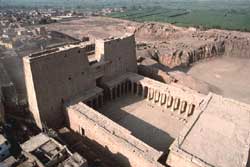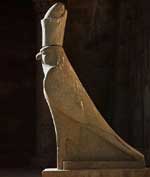|
The Temple of Edfu
 Dedicated
to Horus, the falcon headed god, it was built during the reigns
of six Ptolemies. We have a great deal of information about its
construction from reliefs on outer areas. It was begun in 237 BC
by Ptolemy III Euergetes I and was finished in 57 BC. Dedicated
to Horus, the falcon headed god, it was built during the reigns
of six Ptolemies. We have a great deal of information about its
construction from reliefs on outer areas. It was begun in 237 BC
by Ptolemy III Euergetes I and was finished in 57 BC.
This is not only the best preserved ancient temple in Egypt, but
the second largest after Karnak. It was believed that the temple
was built on the site of the great battle between Horus and
Seth.
The main building, which includes a great Hypostyle Hall, was
uncovered by Mariette in the 1860s.
There are numerous reliefs, including a depiction of the Feast
of the Beautiful Meeting, the annual reunion between Horus and
his wife Hathor. The reliefs are mostly situated on the inside
of the first pylon, and spiritually connect this temple with
Hathor’s Temple at the Dendera complex.
During the third month of summer, the priests at the Dendera
complex would place the statue of Hathor on her barque (a
ceremonial barge) and would thus bring the statue to the Edfu
Temple, where it was believed that Horus and Hathor shared a
conjugal visit.
Each night, the god and goddess would retire to the mamissi, or
berthing house.
 There
is still an entrance colonnade to the mamissi, and reliefs with
considerable remaining color just outside the main temple. These
images portray the ritual of the birth of Harsomtus, son of
Horus and Hathor. There
is still an entrance colonnade to the mamissi, and reliefs with
considerable remaining color just outside the main temple. These
images portray the ritual of the birth of Harsomtus, son of
Horus and Hathor.
The pylons of the main Temple are about 118 feet high with
typical scenes of the pharaoh in battle with his enemies. Within
the pylons is the colonnaded courtyard with distinctive, pared
columns, which leads into the great hypostyle hall. But on
either side of the courtyard there are gates which lead to an
area behind the temple and inside the bounding walls.
Here, there are inscriptions recording donations of land which
were probably transferred from demotic documents.
There are also dramatic images depicting the defeat of Seth by
Horus. There was an annual ritual called the known as the
Triumph of Horus (10 harpoons) which ended in the slaying of a
hippopotamus, the symbol of Seth.
 The
facade of the first hypostyle hall has images honoring Horus and
Hathor, and there is an immaculate ten foot tall colossi of
Horus as the falcon god here (a matching colossi is was
destroyed). Beyond the great hypostyle hall is a second, smaller
hypostyle hall which leads to a well called the Chamber of the
Nile where the Priests obtained pure holy water. The
facade of the first hypostyle hall has images honoring Horus and
Hathor, and there is an immaculate ten foot tall colossi of
Horus as the falcon god here (a matching colossi is was
destroyed). Beyond the great hypostyle hall is a second, smaller
hypostyle hall which leads to a well called the Chamber of the
Nile where the Priests obtained pure holy water.
Beyond the second hypostyle hall is the offering hall, followed
by the vestibule and finally the sanctuary surrounded by chapels
of different gods .
There is a granite naos here dedicated by Nectanebo II, making
it the oldest relic in the temple. The front chapel has a
depiction on the ceiling showing the voyage of the solar barque
through the Twelve Hours of the day, with an inspiring image of
the goddess, Nut. |